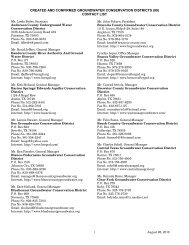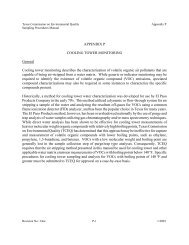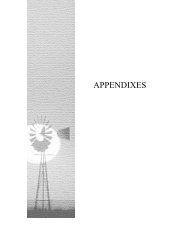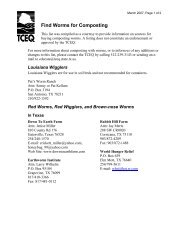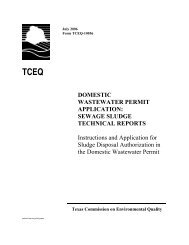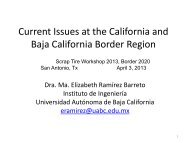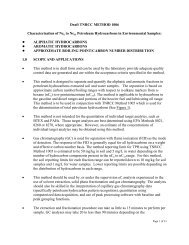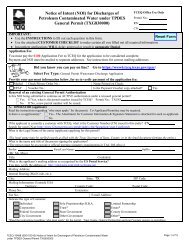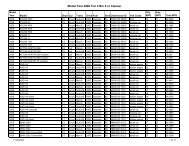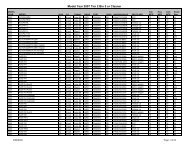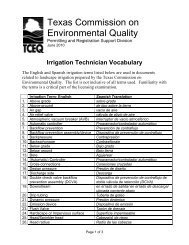29c Western Cross TimbersThe Western Cross Timbers ecoregi<strong>on</strong> covers the wooded areas west <str<strong>on</strong>g>of</str<strong>on</strong>g> the GrandPrairie (29d) <strong>on</strong> sandst<strong>on</strong>e and shale beds <str<strong>on</strong>g>of</str<strong>on</strong>g> Pennsylvanian, Permian, and LowerCretaceous age. The Eastern and Western Cross Timbers (<str<strong>on</strong>g>Ecoregi<strong>on</strong>s</str<strong>on</strong>g> 29b and 29c) in<str<strong>on</strong>g>Texas</str<strong>on</strong>g> are the southern porti<strong>on</strong> <str<strong>on</strong>g>of</str<strong>on</strong>g> a larger area (Ecoregi<strong>on</strong> 29) that extends into Oklahomaand Kansas. The entire regi<strong>on</strong> is a mosaic <str<strong>on</strong>g>of</str<strong>on</strong>g> oak woodland and prairie that forms thetransiti<strong>on</strong> between the eastern deciduous forest and the Great Plains. The oak woodlandis c<strong>on</strong>centrated <strong>on</strong> sandst<strong>on</strong>e substrates while prairie grasses dominate <strong>on</strong> surrounding limest<strong>on</strong>e formati<strong>on</strong>sor interior limest<strong>on</strong>e inclusi<strong>on</strong>s. Trees in the Western Cross Timbers are drought-stressed; they experienceerratic precipitati<strong>on</strong> and seas<strong>on</strong>al extremes in temperature. Trees growing under such c<strong>on</strong>diti<strong>on</strong>s may beseveral hundred years old and no taller than 20 to 30 feet (Stahle et al., 2003).The landscape has cuesta topography that is expressed as lines <str<strong>on</strong>g>of</str<strong>on</strong>g> sandst<strong>on</strong>e ridges with a gentle dip slope<strong>on</strong> <strong>on</strong>e side and a steeper scarp <strong>on</strong> the other (Spearing <str<strong>on</strong>g>199</str<strong>on</strong>g>1). The soils are mostly fine sandy loams with claysubsoils that retain water. Some researchers c<strong>on</strong>tend that these woodland areas would be savanna-like if theyexperienced fire, although <strong>on</strong>e early account described the Cross Timbers as “an immense natural hedge” orbelt <str<strong>on</strong>g>of</str<strong>on</strong>g> thick impenetrable forest. It is likely that with more frequent fire there were more prairie openingsbetween the belts <str<strong>on</strong>g>of</str<strong>on</strong>g> forest, and that closed canopy woodland and park-like savannas were both present.As in the Eastern Cross Timbers (29b), the dominant trees are post oak and blackjack oak with anunderstory <str<strong>on</strong>g>of</str<strong>on</strong>g> shrubs and grasses. The prairie openings historically c<strong>on</strong>tained taller grasses such as big bluestem(Andropog<strong>on</strong> gerardii), yellow Indiangrass (Sorghastrum nutans), and switchgrass (Panicum virgatum)growing <strong>on</strong> deeper soil, and shorter grasses such as sideoats grama (Bouteloua curtipendula), buffalograss(Buchloe dactyloides), and silver bluestem (Bothriochloa laguroides ssp. torreyana) growing <strong>on</strong> shallowsoil. The grassy understory is better developed <strong>on</strong> the red, gravelly soils <str<strong>on</strong>g>of</str<strong>on</strong>g> Pennsylvanian age (Francaviglia2000). The riparian vegetati<strong>on</strong> in the eastern porti<strong>on</strong> <str<strong>on</strong>g>of</str<strong>on</strong>g> Ecoregi<strong>on</strong> 29c resembles that <str<strong>on</strong>g>of</str<strong>on</strong>g> the Grand Prairie(29d) and Eastern Cross Timbers (29b), but, farther to the west, eastern riparian species are gradually replacedby typically western species such as little walnut (Juglans microcarpa), netleaf hackberry (Celtis reticulata),and mesquite (Prosopis glandulosa) (Bezans<strong>on</strong> 2000). The variety <str<strong>on</strong>g>of</str<strong>on</strong>g> ecosystems in the Cross Timbers, i.e.,prairie, open woodland, and thicket, provide diverse habitats for wildlife. In additi<strong>on</strong>, the abundant acorns area staple food source for wild turkeys (Meleagris gallopavo), prairie chickens (Tympanuchus spp.), racco<strong>on</strong>s(Procy<strong>on</strong> lotor), squirrels (Sciurus spp.), and deer (Odocoileus spp.). The area has a l<strong>on</strong>g history <str<strong>on</strong>g>of</str<strong>on</strong>g> coal, oil,and natural gas producti<strong>on</strong> from the Pennsylvanian sandst<strong>on</strong>e, limest<strong>on</strong>e, and shale beds. Deeper soils in theeastern part <str<strong>on</strong>g>of</str<strong>on</strong>g> this ecoregi<strong>on</strong> support a dairy industry, pastureland, and cultivati<strong>on</strong> <str<strong>on</strong>g>of</str<strong>on</strong>g> forage sorghum, silage,corn, and peanuts.The height <str<strong>on</strong>g>of</str<strong>on</strong>g> oak trees in the Cross Timbers is affected bythe depth <str<strong>on</strong>g>of</str<strong>on</strong>g> soil. Here, stunted oaks grow at the edge <str<strong>on</strong>g>of</str<strong>on</strong>g> asandst<strong>on</strong>e outcrop covered with lichen. Photo: R.E. Rosiere,Tarlet<strong>on</strong> State UniversityThe yearly acorn crop from Cross Timbers oaks is an importantfood source for the wild turkey (Meleagris gallopavo).Photo: Albert Lavalle, Nati<strong>on</strong>al Wild Turkey Foundati<strong>on</strong><str<strong>on</strong>g>Ecoregi<strong>on</strong>s</str<strong>on</strong>g> <str<strong>on</strong>g>of</str<strong>on</strong>g> <str<strong>on</strong>g>Texas</str<strong>on</strong>g> 39
Level IV Ecoregi<strong>on</strong>29c. Western Cross TimbersArea (sq. mi.) 8274PhysiographyRolling plains, low rimrock or ridges, and cuesta topography.Elevati<strong>on</strong> /Local Relief (feet)650-1845 /50-300Surficial Geology;Bedrock GeologySoil Order (Great Groups)Comm<strong>on</strong> Soil SeriesSoil Temperature /Soil Moisture RegimesMean Annual Precipitati<strong>on</strong> (in.) 27-35Mean Annual Frost Free Days 220-240Mean Temperature (F)(Jan. min/max; July min/max)Vegetati<strong>on</strong>Land Cover and Land UseQuaternary and Tertiary quartz sand to smectitic clay decompositi<strong>on</strong> residuum,sandy clay and clay loam colluvium;Lower Cretaceous sandst<strong>on</strong>e and clayst<strong>on</strong>e; Upper Pennsylvanian sandst<strong>on</strong>e,mudst<strong>on</strong>e, clayst<strong>on</strong>e.Alfisols (Paleustalfs, Haplustalfs)C<strong>on</strong>vex surfaces: B<strong>on</strong>ti, Exray, Truce, Bluegrove, Windthorst. Erosi<strong>on</strong>alfootslopes: Callahan, Nocken, Duffau. Rolling plains: Chaney, Dem<strong>on</strong>a, Patilo,Nimrod, Cisco.Thermic /Ustic, Udic Ustic30/56;70/96Oak savanna and prairie. Upland forest: post oak, blackjack oak, cedar elm,black hickory, plateau live oak, eastern redcedar, sumac. Riparian forest-east:pecan, black willow, eastern cott<strong>on</strong>wood, sycamore, boxelder. Riparian forest- west: h<strong>on</strong>ey mesquite, netleaf hackberry, little walnut. Grassy understory- relatively undisturbed: big bluestem, little bluestem, yellow Indiangrass,switchgrass, sideoats grama. Grassy understory - grazed: buffalograss, purplethreeawn, curlymesquite, h<strong>on</strong>ey mesquite, lotebush. Understory shrubs and vines:persimm<strong>on</strong>, sassafras, Virginia creeper, greenbriar.Woodland, grassland, shrubland. Grazing, some dairy, some cropland <str<strong>on</strong>g>of</str<strong>on</strong>g> peanuts,grain sorghum, silage, corn, and peaches. Hunting leases. Coal, oil, and natural gasproducti<strong>on</strong>. Some urban and residential, particularly in the eastern porti<strong>on</strong>.29d Grand PrairieThe Grand Prairie ecoregi<strong>on</strong> is an undulating plain underlain by Lower Cretaceouslimest<strong>on</strong>es with interbedded marl and clay. It is bounded <strong>on</strong> the east and west by thesandst<strong>on</strong>es <str<strong>on</strong>g>of</str<strong>on</strong>g> the Cross Timbers, and its open plains c<strong>on</strong>trast with the Cross Timbers oakwoodlands. On the south, the generally smoother surface <str<strong>on</strong>g>of</str<strong>on</strong>g> the Grand Prairie meets themesa or stairstep topography <str<strong>on</strong>g>of</str<strong>on</strong>g> the Limest<strong>on</strong>e Cut Plain (29e).Although the vegetati<strong>on</strong><str<strong>on</strong>g>of</str<strong>on</strong>g> the Grand Prairie is similar to the Northern Blackland Prairie (32a), the limest<strong>on</strong>e<str<strong>on</strong>g>of</str<strong>on</strong>g> the Grand Prairie is more resistant to weathering, which gives the topography a rougher appearance than32a. Ecoregi<strong>on</strong> 29d also has thinner soil and less precipitati<strong>on</strong> than Ecoregi<strong>on</strong> 32a; its locati<strong>on</strong> is transiti<strong>on</strong>albetween the more moist climate <str<strong>on</strong>g>of</str<strong>on</strong>g> east <str<strong>on</strong>g>Texas</str<strong>on</strong>g> and the drier climate <str<strong>on</strong>g>of</str<strong>on</strong>g> the Great Plains. Meandering streamsdeeply incise the limest<strong>on</strong>e surface.The original vegetati<strong>on</strong> was tallgrass prairie in the upland areas and elm (Ulmus spp.), pecan (Caryaillinoensis), and hackberry (Celtis spp.) in riparian areas where deeper soils have developed in floodplaindeposits or where the underlying clays have been exposed by limest<strong>on</strong>e erosi<strong>on</strong>. The invasive species Ashejuniper (Juniperus ashei) and, to a lesser extent, h<strong>on</strong>ey mesquite (Prosopis glandulosa) have increased sinceEuropean settlement. Grand Prairie grasses under minimally disturbed c<strong>on</strong>diti<strong>on</strong>s include big bluestem(Andropog<strong>on</strong> gerardii), yellow Indiangrass (Sorghastrum nutans), little bluestem (Schizachyrium scoparium),sideoats grama (B. curtipendula), and <str<strong>on</strong>g>Texas</str<strong>on</strong>g> cupgrass (Eriochloa sericea). Buffalograss (Buchloe dactyloides),<str<strong>on</strong>g>Texas</str<strong>on</strong>g> wintergrass (Stipa leucotricha), and gramas (Bouteloua spp.) tend to increase with intensive grazing(Bezans<strong>on</strong> 2000). In the spring, abundant forbs create a showy display <str<strong>on</strong>g>of</str<strong>on</strong>g> flowers, as they do <strong>on</strong> EdwardsPlateau (30) grasslands to the south and west.40<str<strong>on</strong>g>Ecoregi<strong>on</strong>s</str<strong>on</strong>g> <str<strong>on</strong>g>of</str<strong>on</strong>g> <str<strong>on</strong>g>Texas</str<strong>on</strong>g>
- Page 1: Below is an Electronic Version <str
- Page 4 and 5: ECOREGIONS OF TEXAS</strong
- Page 6 and 7: TABLE OF CONTENTSABSTRACT..........
- Page 8 and 9: 2526272526272330293235332430323423
- Page 10 and 11: INTRODUCTIONSpatial frameworks are
- Page 12 and 13: Maps of environmen
- Page 14 and 15: vegetation or small areas o
- Page 16 and 17: the only chipmunk in Texas<
- Page 18 and 19: to the north. There is a high deman
- Page 20 and 21: taller, coarser tobosa grass (Pleur
- Page 22 and 23: the fractured rock. The Bof
- Page 24 and 25: hollows, moving upslope to create c
- Page 26 and 27: The headwater catfish (Ictalurus lu
- Page 28 and 29: streams. Two sand plains streams, C
- Page 30 and 31: Several caliche horizons (calcium c
- Page 32 and 33: winds (Spearing 199</strong
- Page 34 and 35: Geology is an important geographica
- Page 36 and 37: the villages of Pa
- Page 38 and 39: Area (sq. mi.) 5569PhysiographyFlat
- Page 40 and 41: Tableland topography of</st
- Page 42: y the Brazos and Colorado rivers ha
- Page 45 and 46: Level IV Ecoregion27i. Broken Red P
- Page 47: Post oaks (Quercus stellata) and bl
- Page 51 and 52: than the limestone of</stro
- Page 53 and 54: underlying the sandstone. This has
- Page 55 and 56: Since settlement, many wildlife spe
- Page 57 and 58: (Pellaeae spp.), Nuttall’s stonec
- Page 59 and 60: Trinity-Edwards aquifer, discharges
- Page 61 and 62: Edwards Plateau to savanna-like con
- Page 63 and 64: species list, prefers fast moving w
- Page 65 and 66: Level IV Ecoregion31a. Northern Nue
- Page 67 and 68: 31c Texas-Tamaulip
- Page 69 and 70: 31d Rio Grande Floodplain and Terra
- Page 71 and 72: 62shrink when dry and swell when we
- Page 73 and 74: 32b Southern Blackland PrairieThe S
- Page 75 and 76: 33 EAST CENTRAL TE
- Page 77 and 78: and need some patchy distubances an
- Page 79 and 80: 33d Northern Prairie OutliersThe sm
- Page 81 and 82: Level IV Ecoregion33e. Bastrop Lost
- Page 83 and 84: 34a Northern Humid Gulf Coastal Pra
- Page 85 and 86: 34b Southern Subhumid Gulf Coastal
- Page 87 and 88: occasional discontinuous drainage r
- Page 89 and 90: oundary was the ability to match th
- Page 91 and 92: Level IV Ecoregion34f. Lower Rio Gr
- Page 93 and 94: live oak trees (Quercus virginiana)
- Page 95 and 96: Shoal grass (Halodule wrightii) mea
- Page 97 and 98: Upland oak-pine forest in Ecoregion
- Page 99 and 100:
35c Pleistocene Fluvial TerracesThe
- Page 101 and 102:
35f FlatwoodsMostly flat to gently
- Page 103 and 104:
pasture, although some woodland sti
- Page 105 and 106:
invariant definition of</st
- Page 107 and 108:
how many stream sites/watersheds ar
- Page 109 and 110:
commonly believed. Typically, about
- Page 111 and 112:
CONCLUSIONS AND RECOMMENDATIONSThis
- Page 113 and 114:
104Ecoregions <str
- Page 115 and 116:
Biggs, B.J.F., M.J. Duncan, I.G. Jo
- Page 117 and 118:
Diggs, G.M., Jr., and P.C. Schulze.
- Page 119 and 120:
Graves, J. 2002. Texas</str
- Page 121 and 122:
Hunt, C.B. 1967. Physiography <stro
- Page 123 and 124:
Maxwell, T.C. 1979. Avifauna <stron
- Page 125 and 126:
Richmond, G.M., D.L. Weide, and D.W
- Page 127 and 128:
U.S. Department of
- Page 129 and 130:
Woods, A.J., J.M. Omernik, D.R. But
- Page 131 and 132:
Herbaceous Plants(Forbs, Grasses, a
- Page 133 and 134:
Hickory, BlackHickory, WaterHollyHu



